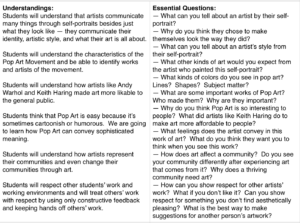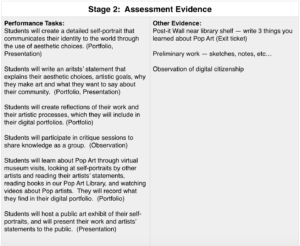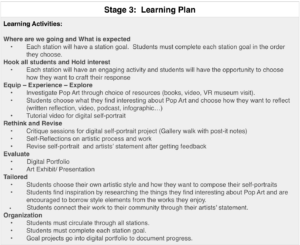
The Understanding by Design (UbD) Plan Template
In EDLD 5313, I have been looking at how to design significant learning experiences for my students. As examples of the sort of planning necessary to create these deep learning opportunities for our students, I’ve been exposed to both the 3-Column Table and the Understanding By Design (UbD) Lesson Planning Template. I discussed the 3-column table in my last post, and in this post, I’ll go over the UbD template, then compare and contrast the two.
Here is what the same lesson from my last post looks like as a UbD plan:
Both systems use backward design to break a lesson down and ensure that all the learning objectives are not just covered, but are well-supported within the structure of the lesson. For teaching art, I think I like the 3-Column Table the best. This provides a more loose framework and more broad parameters in which to define goals. The 3-Column Table, to me, seems to be a nice way to focus on the “big picture,” while not losing sight of all the moving parts. In an elementary art classroom, there are a LOT of moving parts!
The UbD template (above) to me seems to be more appropriate for a course that has very specific goals or outcomes, like maybe a middle- or high-school math or science course. In art, I could see this being used to plan learning experiences with very specific objectives and products. I think it would be especially handy for planning specific modules within a larger unit or course.
I like both models for very different reasons. I feel that the 3-Column Table helped me to visualize connections between goals that I might not have given much thought to. I think the 3-column table is a really good fit for my program, because I have so much to cover with so little time each week with my students. I tend to have many paths for my students to choose from in order to reach understanding. I feel like the UbD template might be overkill for each, individual learning experience, but the 3-Column Table is entirely manageable.
Resources:
Fink, L. D. (2003). A Self-Directed Guide to Designing Courses for Significant Learning.Creating Significant Learning Experiences: An Integrated Approach to Designing College Courses. San Francisco: Jossey-Bass.
Wiggins, G. & McTighe, J. (2005). Understanding by Design (expanded second ed.). Alexandria, Virginia: Association for Supervision and Curriculum Development.




